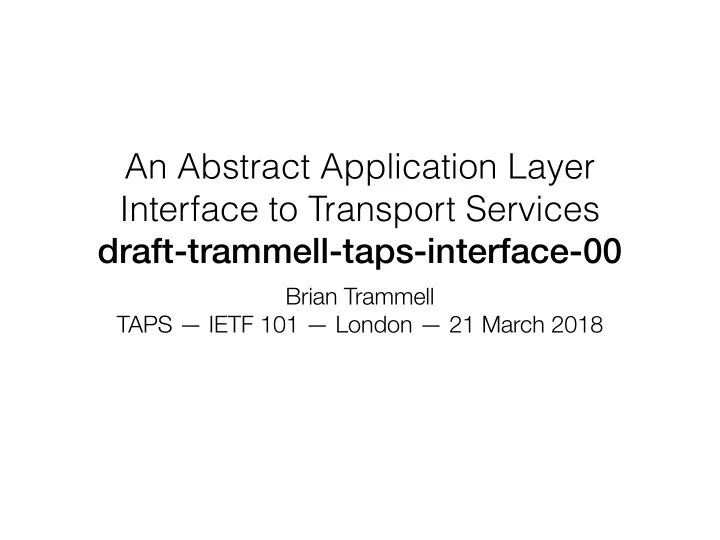

An Abstract Application Layer Interface to Transport Services draft-trammell-taps-interface-00 Brian Trammell TAPS — IETF 101 — London — 21 March 2018
Architecture Diagram Application Establi shment Termi nation Data Transfer Events Pre-Establishment Basic Objects Transport Services API Transport Services Candidate Implementation Gathering Cached State Candidate Racing System Policy Protocol Stack(s) Interface - TAPS - B Trammell - IETF 101 2
Interface Design Principles (§3) We set out to define a single interface to a variety of transport protocols to be used in a variety of application design patterns, to enable applications written to a single API to make use of multiple transport protocols in terms of the features they provide, providing: • explicit support for security properties as first-order transport features; • asynchronous connection, transmission, and reception; • support for multistreaming and multipath transport protocols; and • atomic transmission of data , using application-assisted framing and deframing where necessary. Interface - TAPS - B Trammell - IETF 101
Interface Diagram Application Establi shment Termi nation Data Transfer Events Pre-Establishment Transport Services API Parameters Preconnection Connection Connection Group Endpoints Local Remote Interface - TAPS - B Trammell - IETF 101 4
Endpoints (§5.1) • Remote and local endpoints can be specified at a variety of resolutions (e.g. hostname / service name, address / port, interface). • Resolution is under transport services control, not application control. • May depend on PvD / selected protocol stack. • Open issue: resolution can leak interest when DNS is not private. Interface - TAPS - B Trammell - IETF 101
Transport Parameters (§5.2): Protocol and Path Selection Properties • Protocol and path selection properties used to select/eliminate candidates during connection establishment. • Five levels of preference: require, prefer, ignore, avoid, prohibit. • Properties derived from minset: • Reliable Data Transfer • RTX and ICMP notification • Preservation of Ordering • Checksum coverage control • Per-Message Reliability • Capacity profile • 0-RTT Session Establishment • (path-only) Interface Type • Multiplexing (multistreaming) Interface - TAPS - B Trammell - IETF 101
Transport Parameters: Protocol Properties (§9.1) • Generic protocol properties allow configuration and querying of protocol stacks in a transport-independent way: • Relative Niceness within group • Maximum non-fragmented message size • Group TX scheduler • Maximum non-partial message • Connection Abort timeout size on send • RTX notification threshold • Maximum non-partial message • Minimum checksum coverage size on receive • Maximum 0RTT message size • Specific protocol properties allow specific stacks to be configured in detail, should they be selected. Interface - TAPS - B Trammell - IETF 101
Transport Parameters: Security Parameters (§5.3) • Generic security properties allow configuration and querying of security features in a protocol-independent way: • Identity • Session Cache configuration • Private Key • Pre-shared keys • Groups • Trust verification and • Algorithms identity challenge • Ciphersuites callbacks Interface - TAPS - B Trammell - IETF 101
Preconnection (§5) Parameters Preconnection Connection • A preconnection describes Endpoints the state of a connection that might exist in the future, including parameters and endpoint specifiers. • This design allows the system to prepare and cache information based on application requirements before establishment • Preconnections can also be used to group connections before establishment. • Implementations of the interface may provide convenience calls to connect via an implicit preconnection. Interface - TAPS - B Trammell - IETF 101
Establishing Connections (§6) Connection • Three ways to establish a connection: • Active ( Initiate() ): application notified that the connection is up by a Ready<> event. • Passive ( Listen() ): application notified of each incoming connection by a ConnectionReceived<> event. • Simultaneous/Peer ( Rendezvous() ): application notified connection is up by a RendezvousDone<> event • Data can be sent on an initiating connection immediately. • Details of 0RTT still an open issue. Interface - TAPS - B Trammell - IETF 101
Connection Groups (§6.4) Connection Connection Group • Connections can be entangled into groups • All connections in a group share protocol properties and may share connection state. • Connections in a connection group are implemented as streams in a multistreaming protocol when available. • Preconnection.Clone() creates preconnections whose eventual connections will be entangled. • Connection.Clone() creates a new connection entangled with an existing one. • New streams yield a ConnectionReceived<> event Interface - TAPS - B Trammell - IETF 101
Sending Data (§7) • Data (as a Message) sent with Connection.Send() • Sender-side framing allows for arbitrarily-typed application objects to be converted to octet streams. • Send parameters control per-Send behavior: • Lifetime • Checksum Coverage • Niceness • Immediate Acknowledgment • Ordered • Instantaneous Capacity Profile • Idempotent • Sending may yield Sent<> or Expired<> events Interface - TAPS - B Trammell - IETF 101
Receiving Data (§8) • Application indicates readiness to receive via Connection.Receive() , message sent to application via supplied callback. • Message contains an octet array, as well as transport metadata • Messages are split from octet via application-provided receiver-side deframing when the transport doesn't provide its own framing • Very large messages or lack of deframing may result in partial reception Interface - TAPS - B Trammell - IETF 101
Connection Termination (§10) • Connection.Close() : orderly connection shutdown after pending send and receive, results in Connection.Closed<> event • Underlying stack closes after last Connection in a Group closes. • Connection.Abort() : immediate connection shutdown, results in Connection.Aborted<> event • All Connections in a Group abort simultaneously. Interface - TAPS - B Trammell - IETF 101
Interface Diagram Parameters Require() Prefer() Ignore() Avoid() Prohibit() Security parameters (Identity, PrivateKey, Algorithm, Group, Ciphersuite) Connection Preconnection Clone() → Initiate() → Ready<> Connection Group Clone() Listen() → CReceived<> Send() → Sent<>, Expired<> Rendezvous() → RDone<> Receive() → Received<> Close() → Closed<> Abort() → Aborted<> Endpoints Local Remote Interface - TAPS - B Trammell - IETF 101 15
Recommend
More recommend